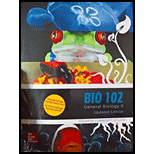
Concept explainers
To describe:
The proportion of offspring being heterozygous for all the genes.
Concept introduction:
Mating between two ferns, one having genotype
Explanation of Solution
Tabular representation:
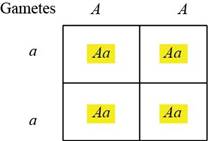
Table.1: The progeny obtained by crossing AA and aa.
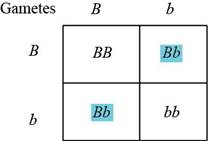
Table.2: The progeny obtained by crossing Bb and Bb.
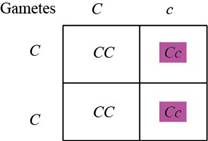
Table.3: The progeny obtained by crossing Cc and CC.
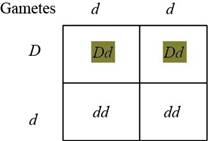
Table.4: The progeny obtained by crossing dd and Dd.
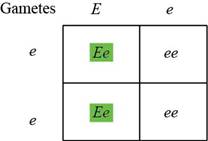
Table.5: The progeny obtained by crossing Ee and ee.
Explanation:
The genotypes for the first traits are AA and aa. The gametes formed by these will be as follows:
The offspring obtained from crossing can be observed in the Punnett square in Table.1: “The progeny obtained by crossing AA and aa”. All the offspring would be heterozygous. The probability of having heterozygous offspring from first trait is
The genotypes for the second traits are Bb and Bb. The gametes formed by these will be as follows:
The probability of offspring produced from crossing can be observed in the Punnett square in Table.2: “The progeny obtained by crossing Bb and Bb”. There will be
The genotypes for the third traits are Cc and CC. The gametes formed by these will be as follows:
The offspring obtained from crossing can be observed in the Punnett square in Table.3: “The progeny obtained by crossing Cc and CC”. There will be
The genotypes for the fourth traits are dd and Dd. The gametes formed by these will be as follows.
The offspring obtained from crossing can be observed in the Punnett square in Table.4: “The progeny obtained by crossing dd and Dd”. There will be
The genotypes for the fifth traits are Ee and ee. The gametes formed by these will be as follows.
The offspring obtained from crossing can be observed in the Punnett square in Table.5: “The progeny obtained by crossing Ee and ee”. There will be
The probability of offspring heterozygous for all the traits can be calculated using the product rule that is by multiplying individual probabilities of heterozygotes for each trait. The probability of offspring heterozygous for all genes can be calculated as follows:
The probability of offspring heterozygous for all the genes is
Want to see more full solutions like this?
Chapter 10 Solutions
BIO 102 General Biology II Updated Edition (Tidewater Community College)
- Explain how the hormones of the glands listed below travel around the body to target organs and tissues : Pituitary gland Hypothalamus Thyroid Parathyroid Adrenal Pineal Pancreas(islets of langerhans) Gonads (testes and ovaries) Placentaarrow_forwardWhat are the functions of the hormones produced in the glands listed below: Pituitary gland Hypothalamus Thyroid Parathyroid Adrenal Pineal Pancreas(islets of langerhans) Gonads (testes and ovaries) Placentaarrow_forwardDescribe the hormones produced in the glands listed below: Pituitary gland Hypothalamus Thyroid Parathyroid Adrenal Pineal Pancreas(islets of langerhans) Gonads (testes and ovaries) Placentaarrow_forward
- Please help me calculate drug dosage from the following information: Patient weight: 35 pounds, so 15.9 kilograms (got this by dividing 35 pounds by 2.2 kilograms) Drug dose: 0.05mg/kg Drug concentration: 2mg/mLarrow_forwardA 25-year-old woman presents to the emergency department with a 2-day history of fever, chills, severe headache, and confusion. She recently returned from a trip to sub-Saharan Africa, where she did not take malaria prophylaxis. On examination, she is febrile (39.8°C/103.6°F) and hypotensive. Laboratory studies reveal hemoglobin of 8.0 g/dL, platelet count of 50,000/μL, and evidence of hemoglobinuria. A peripheral blood smear shows ring forms and banana-shaped gametocytes. Which of the following Plasmodium species is most likely responsible for her severe symptoms? A. Plasmodium vivax B. Plasmodium ovale C. Plasmodium malariae D. Plasmodium falciparumarrow_forwardStandard Concentration (caffeine) mg/L Absorbance Reading 10 0.322 20 0.697 40 1.535 60 2.520 80 3.100arrow_forward
- please draw in the answers, thank youarrow_forwarda. On this first grid, assume that the DNA and RNA templates are read left to right. DNA DNA mRNA codon tRNA anticodon polypeptide _strand strand C с A T G A U G C A TRP b. Now do this AGAIN assuming that the DNA and RNA templates are read right to left. DNA DNA strand strand C mRNA codon tRNA anticodon polypeptide 0 A T G A U G с A TRParrow_forwardplease answer all question below with the following answer choice, thank you!arrow_forward

 Human Biology (MindTap Course List)BiologyISBN:9781305112100Author:Cecie Starr, Beverly McMillanPublisher:Cengage Learning
Human Biology (MindTap Course List)BiologyISBN:9781305112100Author:Cecie Starr, Beverly McMillanPublisher:Cengage Learning Concepts of BiologyBiologyISBN:9781938168116Author:Samantha Fowler, Rebecca Roush, James WisePublisher:OpenStax College
Concepts of BiologyBiologyISBN:9781938168116Author:Samantha Fowler, Rebecca Roush, James WisePublisher:OpenStax College Human Heredity: Principles and Issues (MindTap Co...BiologyISBN:9781305251052Author:Michael CummingsPublisher:Cengage Learning
Human Heredity: Principles and Issues (MindTap Co...BiologyISBN:9781305251052Author:Michael CummingsPublisher:Cengage Learning Biology (MindTap Course List)BiologyISBN:9781337392938Author:Eldra Solomon, Charles Martin, Diana W. Martin, Linda R. BergPublisher:Cengage Learning
Biology (MindTap Course List)BiologyISBN:9781337392938Author:Eldra Solomon, Charles Martin, Diana W. Martin, Linda R. BergPublisher:Cengage Learning





